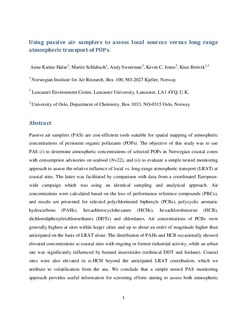| dc.contributor.author | Halse, Anne Karine | |
| dc.contributor.author | Schlabach, Martin | |
| dc.contributor.author | Sweetman, Andy | |
| dc.contributor.author | Jones, Kevin C | |
| dc.contributor.author | Breivik, Knut | |
| dc.date.accessioned | 2017-12-04T12:05:41Z | |
| dc.date.available | 2017-12-04T12:05:41Z | |
| dc.date.created | 2012-09-26T20:01:06Z | |
| dc.date.issued | 2012 | |
| dc.identifier.citation | Halse, A.K., Schlabach, M., Sweetman, A., Jones, K.C., Breivik, K. (2012). Using passive air samplers to assess local sources versus long range atmospheric transport of POPs. Journal of Environmental Monitoring, 14, 2580-2590. 10.1039/C2EM30378G | nb_NO |
| dc.identifier.issn | 1464-0325 | |
| dc.identifier.uri | http://hdl.handle.net/11250/2469006 | |
| dc.description.abstract | Passive air samplers (PAS) are cost-efficient tools suitable for spatial mapping of atmospheric concentrations of persistent organic pollutants (POPs). The objective of this study was to use PAS to (i) determine atmospheric concentrations of selected POPs in Norwegian coastal zones with consumption advisories on seafood (N = 22), and (ii) evaluate a simple nested monitoring approach to assess the relative influence of local vs. long-range atmospheric transport (LRAT) at coastal sites. The latter was facilitated by comparison with data from a coordinated European-wide campaign in which an identical sampling and analytical approach was followed. Air concentrations were calculated based on the loss of performance reference compounds (PRCs), and results are presented for selected polychlorinated biphenyls (PCBs), polycyclic aromatic hydrocarbons (PAHs), hexachlorocyclohexanes (HCHs), hexachlorobenzene (HCB), dichlorodiphenyltrichloroethanes (DDTs) and chlordanes. Air concentrations of PCBs were generally highest at sites within larger cities and up to about an order of magnitude higher than anticipated on the basis of LRAT alone. The distribution of PAHs and HCB occasionally showed elevated concentrations at coastal sites with ongoing or former industrial activity, while an urban site was significantly influenced by banned insecticides (technical DDT and lindane). Coastal sites were also elevated in a-HCH beyond the anticipated LRAT contribution, which we attribute to volatilization from the sea. We conclude that a simple nested PAS monitoring approach provides useful information for screening efforts aiming to assess both atmospheric burdens as well as the relative significance of local sources in controlling these burdens at sites in contaminated areas. | nb_NO |
| dc.language.iso | eng | nb_NO |
| dc.title | Using passive air samplers to assess local sources versus long range atmospheric transport of POPs | nb_NO |
| dc.type | Journal article | nb_NO |
| dc.description.version | acceptedVersion | nb_NO |
| dc.rights.holder | © The Royal Society of Chemistry 2012 | nb_NO |
| dc.source.pagenumber | 2580-2590 | nb_NO |
| dc.source.volume | 14 | nb_NO |
| dc.source.journal | Journal of Environmental Monitoring | nb_NO |
| dc.source.issue | 10 | nb_NO |
| dc.identifier.doi | 10.1039/c2em30378g | |
| dc.identifier.cristin | 946948 | |
| dc.relation.project | Norges forskningsråd: 208431 | nb_NO |
| cristin.unitcode | 7460,60,0,0 | |
| cristin.unitcode | 7460,57,0,0 | |
| cristin.unitname | Miljøkjemi | |
| cristin.unitname | Atmosfære og klima | |
| cristin.ispublished | true | |
| cristin.fulltext | postprint | |
| cristin.qualitycode | 0 | |
